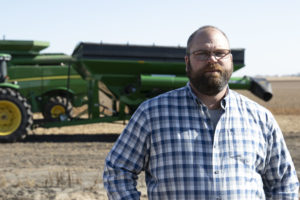
Partnerships That Drive Success
Guests: Todd Arduser, Kevin Poppel
In this episode of Channel Chat, farmer Kevin Poppel talks about the relationships and advice that have helped him find success in farming.
Listen to Episode
 Ag Over Easy Podcast
Ag Over Easy Podcast
Grain marketing expert Matt Bennett joins Channel Chat this week to discuss the USDA September Crop Production Report. Tune in to get a timely analysis as we head into the 2018 harvest season.


Matt Bennett is not only one of the industry's most respected grain marketing consultants but he's also a farmer himself. With a 3,000-acre corn and soybean farm, Matt understands firsthand the challenges and risks involved in being a farmer. Matt takes his decades of successful experiences, on and off the farm, to provide you with his time-proven approach to grain marketing.
Pam Fretwell
Welcome to another episode of Channel Chat. I'm your host, Pam Fretwell, and today with me, I'm excited to have Mr. Matt Bennett back on the podcast with us for another grain marketing discussion. Now today, we're gonna be talking about the September crop production report from the USDA. Matt, just kinda give us some insights after you reviewed this report? What do you think?
Matt Bennett
The September, typically, it can be a real gamechanger because in August, whenever the USDA looks at the corn crop, they don't actually take ears and see how heavy they are, count crows if you will. So the September report, it usually is a little more refined, not to mention we can't get away from the fact that this crop is so much farther along than a typical September report might suggest. And so most people felt like The USDA have a pretty darn good handle on what the corn crop especially would be looking like.
The interesting thing about the report today is that the trade completely got it wrong as far as corn was concerned. The average trade guess, according to Reuters, from folks like myself who submit in essence their guesses as to what the USDA will come up with was 177.8 bushels per acre, whereas the USDA came out with 181.3. Coming out with 181.3 boosted the crop production in totality to 14.827 billion bushels, which is around 250 million bushels bigger than the August report.
And so where did all this corn come from? You look at this as compared to last month and states like Illinois were forecasted to have a 207-bushel yield in the month of August according to the USDA, whereas the September report actually came out with a yield for Illinois of 214 bushels an acre. Iowa, up at 206 bushel per acre. Indiana got 192. So as far as this report is concerned from a production standpoint, whenever we look at it as far as corn is concerned, the trade got it drastically wrong.
Now the soybean situation is different. The average trade guess is 52.2, which was an increase of 0.6 bushels from the August estimate of 51.6, but the trade ended up at 52.8 So the average guess was low. It wasn't near as low as what we saw I guess with corn. And so, yes, it is the big bean crop most people thought that it was gonna be, an awfully large bean crop. But 52.8, essentially, it's definitely a bearish number. And that gives you a total production of 4.693 billion bushels, which is an increase of a little more than a 100 million bushels from last month. So those are the main numbers we're looking at from a production standpoint.
Pam Fretwell
Let's go to the beans just for a second because you were talking about the different trade guesses on the corn and beans, but yet the markets really didn't react the way that we thought that they would. They closed higher for the day.
Matt Bennett
Yeah. Absolutely. And so whenever we look at the way the markets close, corn had a different type of day than the bean market. Corn closed down, whereas as you suggested, beans closed higher. And so November bean futures closed eight and a quarter higher at 8.40. Whenever we look at some of the numbers they threw at us, not only the production, but shoot Pam, whenever you look at the Indian stocks for September, 845 million bushels was what we came up with, which that's 60 million bushels more than last month in the month of August and it's definitely higher than what the average trade guess was.
And so why did we settle higher today? The interesting thing about the market today is that it certainly was a bearish report, and then we found out early on in the trading session that the United States is actually sending an invitation to the Chinese trade delegation to sit down and talk about our tariff situation, which obviously is most heavily impacted. But whenever we look at the amount of space with soybeans, and so the farmer actually is probably taking the brunt of this trade situation quite heavily. Definitely a very interesting bit of information for the trade. And it was certainly met with a fair amount of speculative buying.
Pam Fretwell
So do you think that that was the reason for the higher prices was that U.S. going to china and talking about their export to China of soybeans?
Matt Bennett
I think it would be pretty tough to argue otherwise. Whenever I look at the production... We were certainly at the high end of the range on average trade guesses, not only for production but yield. Whenever we look at Indian stocks, we were at higher than the average trade guesses. Well, whenever you look at world stocks, world stocks for the September report came in at 108.3 million metric tons, which was an increase of over 2 million metric tons from last month and higher than the average trade guess.
So there really wasn't anything in this report that I could even call neutral, let alone bullish. It was certainly a bearish report. So a person has to look at this market from a little bit different lens. And I think one thing, the only thing that I can really put my finger on would be this situation we have with the U.S. and China trade spat, which as we all know has definitely had an adverse effect on the market.
Pam Fretwell
So what are some of the biggest takeaways that the guys need to thinking about when it comes to their marketing for this year and into next?
Matt Bennett
Right. And that's a great question because we're right here at the start of harvest, so a lot of producers held onto a fair amount of old crop stocks going into harvest, simply because we've been in a situation where the markets have not rewarded us with any sort of a late-season rally. A lot of that had to do with the weather that we talked about previously, basically being conducive to big crops.
The other thing is the basis has definitely deteriorated. And so with basis being in a tough spot essentially, not only have we had a little bit of a challenge from the futures perspective, but cash grains has simply not been anything anybody wanted to own too much because there's so much of it out there.
What's a producer do with a report like this? I wanna tell most producers, I know this has been a year where you've had opportunities to sell. Not all of us have gotten enough sold. I certainly understand that. But if you have storage on the farm, I do thing there's a story, especially in this corn market later on in the calendar year, I would store every bushel I possibly can on the farm at home.
Whenever I look at, not only the U.S. but the world situation as far as Indian stocks go, we can't lose sight of the fact that we're dropping Indian stocks in the U.S., even with a [inaudible 00:06:40] large crop, we're dropping Indian stocks almost 250 million bushels from this September 1st to the next September 1st. And so that's a significant draw down in stocks.
Whenever I look at it from a world perspective, the drawn down in stocks is also significant. You're looking at the world stocks with corn essentially dropping about 75 million metric tons year on year. And so that's just an enormous amount of a draw down in stocks. So later in the year, basis should improve. You might be able to find people hunting for corn a little bit more than what they are today. A producer who puts that corn in the bin is most likely gonna be rewarded.
The carry in the market, which would be the difference in price. For instance, December corn settled today at 352.5. July corn is at 379. That's a 26.5 cent carry. So whenever I talk about carry in the market is suggesting the thing to do is just hold on today that grain. The problem you run into is when you run out of on-farm storage, commercial storage is gonna eat up a good chunk of that carry in the market, if not all of it, and it makes it to where a producer has a got a little bit more tricky situation if they don't have on-farm storage for these excess bushels.
Pam Fretwell
Absolutely. Well, that's a good point as far as the corn and the demand out there. Matt, thanks again for joining us on our podcast today. It's always exciting, really informative to hear your insight on grain marketing topics. Now if you found our discussion helpful today, make sure that you sign up for Matt's weekly grain marketing e-mails on channel.com/email. And to learn more about this podcast and the upcoming episodes, go to channelpodcasting.com. Make sure to subscribe on iTunes, Stitcher, Google Play, or even SoundCloud so you never miss an episode. Thanks everyone.

Guests: Todd Arduser, Kevin Poppel
In this episode of Channel Chat, farmer Kevin Poppel talks about the relationships and advice that have helped him find success in farming.
Listen to Episode

Guests: Colby Woods, Jessica Grubbs
As technology in agriculture continues to evolve, Channel Seedsman Colby Woods wanted to get ahead of the pack and offer drone scouting to his farmers in Eastern Nebraska. We caught up with Colby in Wahoo, Nebraska, along with Sentera Sales and Training Specialist Jessica Grubbs. Listen in this episode of Channel Chat.
Listen to Episode